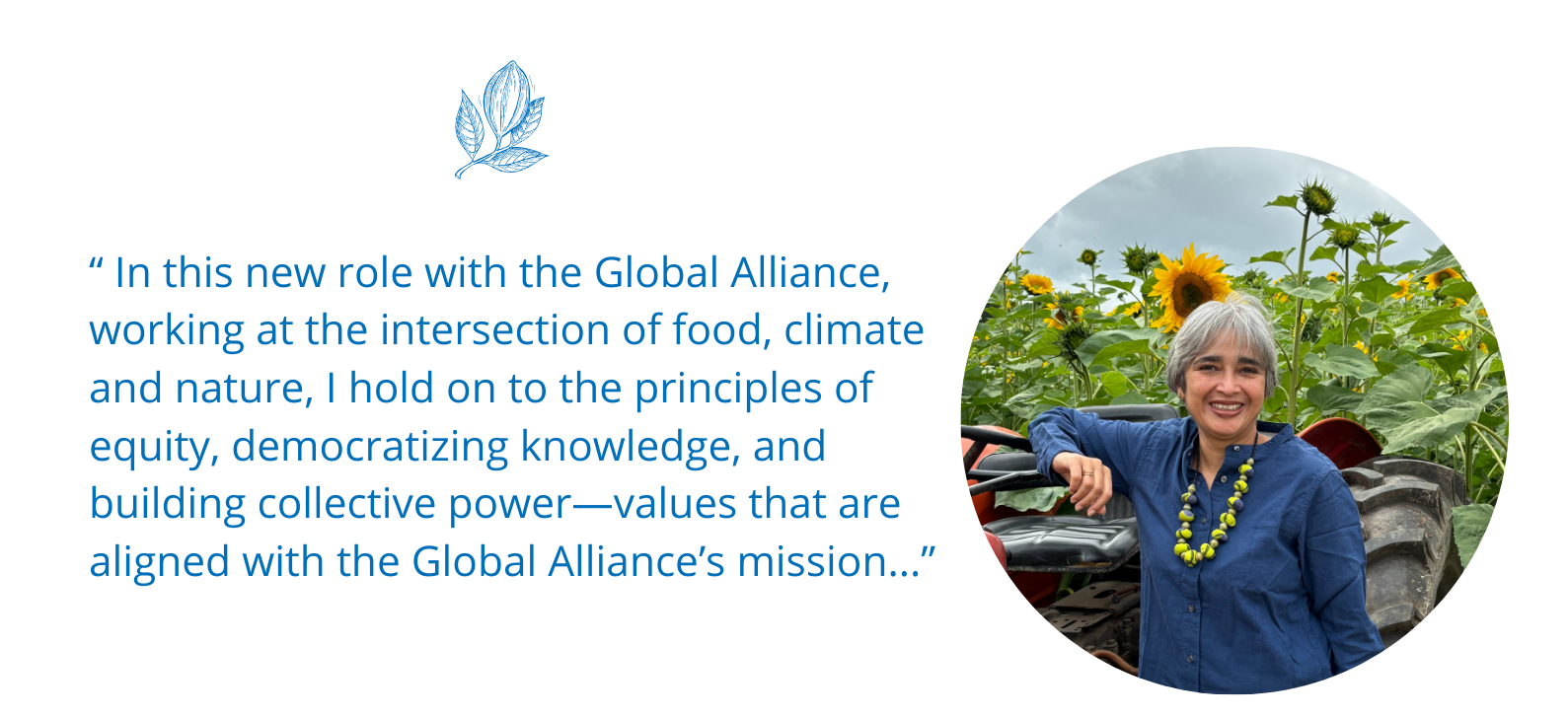Ruchi Tripathi, our new Climate and Nature Director, shares lessons from working with food sovereignty movements
I am thrilled to start my role as Climate and Nature Director at the Global Alliance. As with any transition, I take this as an opportunity to pause and reflect—about what has been and what’s to come, about lessons learnt and opportunities ahead.
Early in my career, I had the privilege to work with and learn from pioneers in the food sovereignty and agroecology movements in Asia, from communities preserving Indigenous rice varieties, fighting for land rights, and committed to making entire villages chemical and pesticide-free.
Addressing a broken food system, like unjust patents, harmful subsidies, industrial agriculture, and the marginalization of women smallholder farmers, has been a central plank of my work over the past decades. However, as important as it is to zoom in on all that is going wrong, I realize this needs to be accompanied by creating, supporting and centring ‘alternatives’ and real solutions that work for millions of small-scale food producers, Indigenous Peoples, and rural women around the world.
LINKING THE GLOBAL TO THE LOCAL
As someone who straddled policy spaces—like the UN and international fora—while working with communities, one early lesson was the importance of linking people’s lived realities with global policy processes. For instance, advocating against patents—on plant varieties, on seeds, and on Indigenous knowledge—was not enough if the very seeds and knowledge we were supporting women and Indigenous communities to protect were disappearing. I owe my education on this to the grounded practice of allies in social movements and civil society, valuing their work of protecting and preserving agrobiodiversity through community seed banks alongside the struggle to stop ‘patents on life’; strengthening territorial markets alongside the fight for fair trade policies; empowering women’s collectives alongside efforts to reform company law to curb the buying power of large agribusinesses.
In this new role with the Global Alliance, working at the intersection of food, climate and nature, I hold on to the principles of equity, democratizing knowledge, and building collective power—values aligned with the Global Alliance’s mission. An alliance of philanthropies working together on food systems transformation has unique levers to make meaningful change, to authentically play our part in the wider food movement, and to stand ready to uplift solutions from grassroots movements for those living at the sharp end of the food and climate crises.

TACKLING TWIN TRANSITIONS
It is a busy time to embark on this new journey. On the one hand, momentum to make food systems climate resilient, equitable, and just is growing while on the other, we face a grim reminder from a recent UN report showing that global hunger levels remain unacceptably high for a third year in a row.
Growing food sustainably amidst a climate and ecological emergency requires upending industrial, fossil-fuel-driven food systems. To address the cross-cutting challenges of climate change, biodiversity loss, and hunger, we need to focus on two transitions at the same time:
i) Firstly, turning agriculture and food from a source of the problem to a solution. Industrial agriculture accounts for nearly a third of greenhouse gas emissions and 15% of global fossil fuel use annually. Shifting away from this requires moving multiple levers of power. Challenging political power and corporate capture by vested interests who resist regulatory and policy changes on the status quo. Influencing financial power, the ability and need to move money away from harmful subsidies towards sustainable food systems. And the power of knowledge and narratives in the public discourse—to not just fight the firehose of mis-and disinformation—but to also uplift the stories of change and demonstrate the possibility and necessity for a fairer, healthier and more just future.
ii) Secondly, investing in and supporting Indigenous and smallholder food producers in agroecological food systems and in a just transition to new and green jobs. It is exciting to see how philanthropy can work together to scale this transition by moving resources where they are needed the most. Agroecological enterprises and solidarity markets are crucial for food producers to build collective power and gain a greater share of their produce in markets.
While engaging and tracking progress in global policy processes—such as the three Rio Conventions—the intergovernmental negotiations on climate change, biodiversity and land (all of which meet this year) we know in reality people do not live their lives in such silos. There are clear overlaps across each of these and policymakers must account for the synergies, trade-offs, and co-benefits to fully achieve the goals of any of these conventions and the Sustainable Development Goals. Likewise, outcomes from these must be linked to other fora such as the Committee on World Food Security (CFS), as well as discussions at the International Labour Organization (where conversations on just transition are underway).
We need to work through approaches that systematically offer solutions to all of these different challenges of food security, climate and biodiversity crisis, and land rights. Agroecology is one such approach that can address multiple challenges with cascading benefits not just on food and nutrition security but on people’s health and the environment. Scientific evidence now supports what Indigenous Peoples, peasant organizations, and women’s groups have long been pushing for—localized, decentralized, agroecological food systems that honour people’s knowledge and preserve agrobiodiversity and rich cultural heritage. The IPCC Assessment 6 reports states with high confidence that the “adoption of agroecology principles and practices will be highly beneficial to maintaining healthy, productive food systems under climate change.”
I look forward to working with the Global Alliance members, partners, and movement leaders to bring the climate, nature, and food worlds together—and in our collective endeavour to find solutions that work for people and the planet.
———————-
Header photo by Peter Casier (CGIAR)

